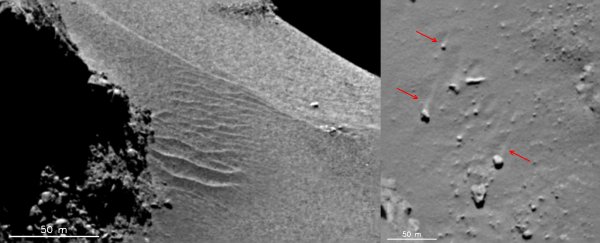In an impressive slew of seven separate papers published today in a special issue of the journal Science, researchers have released their initial observations of Comet 67P/Churyumov-Gerasimenko (or 67P/C-G as we refer to it for short…because honestly we still can't pronounce the full name).
Among discoveries about the comet spraying jets of gas and dust all over the Solar System and its magnetosphere, the team also described unexpected ripples, dunes and windtail structures on the comet's surface, captured by the European Space Agency's Rosetta probe.
These features are surprising for scientists because the comet doesn't have an atmosphere, and therefore it isn't expected to have wind. So… what could be causing the unusual lumps and bumps, some of which you can see in the image above?
Kenneth Chang from the New York Times asked one of the researchers just that, and found that it may have to do with the extremely low gravity on the surface of the comet. He explains:
"You have to ask yourself, is that possible?" said Nicolas Thomas, a professor of experimental physics at the University of Bern in Switzerland and lead author of one of the papers. Dr. Thomas said that back-of-the-envelope calculations indicated that it might be plausible, with the jets of gas acting as wind and the particles held together through intermolecular attraction known as the van der Waals force instead of gravity. "You can convince yourself you can make them move," Dr. Thomas said. "It's plausible, at least at the moment."
There were also a bunch of other strange features, such as steep cliffs, boulders, huge cracks and then stretches of flat terrain. In that flat terrain, they found "very, very bizarre" circular structures, as Thomas told Chang. "To be frank, we don't know how those things were created. We have no clue," he added.
The team even found a crack that's several metres across and almost a kilometre long on the comet's neck. To describe the surface, the scientists divided it into 19 regions, named, appropriately, after Egyptian gods, which you can see below.
Unfortunately, across their observations there was one thing the researchers failed to observe - Philae, the little washing-machine sized lander that famously bounced and then landed on the comet back in November (you can listen to the satisfying crunch it made here).
In its 60 short hours of battery life, Philae managed to detect organic compounds on the comet, and the team now hopes it will wake up again once it receives enough sunlight to charge its batteries, which is expected could happen in the next few months as the comet approaches the Sun.
And even if that doesn't happen, the Rosetta researchers believe that they'll be able to see it again in August, when the comet makes its closest approach to the Sun, as Chang reports for the New York Times.
Perhaps one of the most fascinating discoveries was that the huge frozen comet would actually float - if you could find a big enough pond.
Marcus Woo explains over at Wired:
Like other known comets, the density of comet 67P is about half that of water ice. Initial measurements reveal that it's also very porous - as much as 80 percent of it may be empty space. Rosetta has found depressions, which may have formed when the surface collapsed over particularly porous material underneath.
Of course, while we now know so much more about comets than we did six months ago, there's still plenty to learn. And these papers are just the kick off.
"This sets the baseline for the rest of the mission," project scientist Matt Taylor told Chang.
Find out more about the discoveries made across the other seven papers over at the New York Times or Wired. And get excited - we seriously can't wait to see what Rosetta discovers next.
You can also see some of Comet 67P/C-G's vital stats in the handy ESA image below.
Sources: New York Times, Wired


